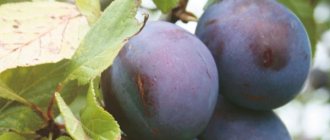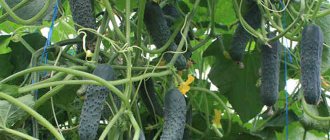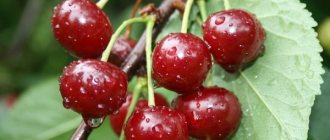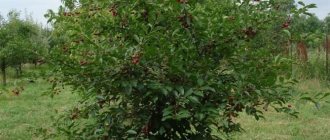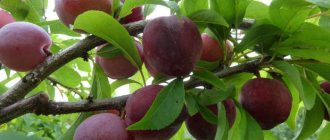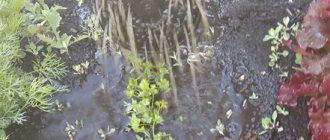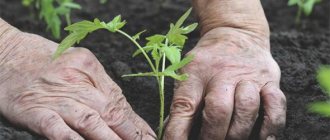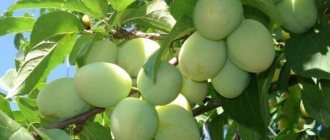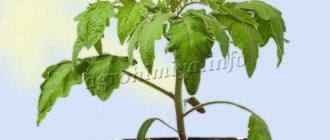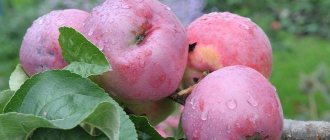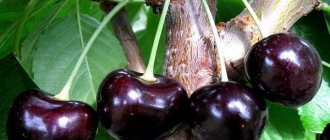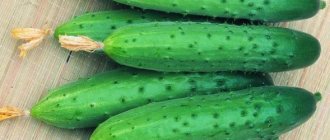History of variety selection
There are not so many varieties of columnar plums. Imperial is a worthy representative of this group. The author of the variety is the domestic breeder Eremin G.V. At the moment, there are very few reviews about the columnar plum Imperial. However, some owners of small plots have already appreciated the compact tree from the best side.
Care
The White Honey plum variety does not require any special care. It is enough to carry out the standard agrotechnical manipulations necessary for a fruit tree in a timely manner so that it consistently produces a good harvest.
Watering
Abundant watering of Belaya Honey is necessary only in the first 2-3 months after planting. To do this, water the plum at least once every two weeks, using 2-3 buckets of water. In the future, it is necessary to maintain moisture in the soil around the tree during the flowering period and at the beginning of fruit growth.
In the second half of summer, there is no need to water abundantly to prevent additional shoot growth. It should be borne in mind that White Honey Plum tolerates drought well, so it does not require frequent watering.
Trimming
The White Honey plum variety needs to be pruned every year. This procedure should not be neglected, since it is not only important for the ripening of high-quality fruits, but also prevents the development of diseases.
Pruning is done in early spring before sap flow begins. In the first few years, the crown is formed, removing branches that thicken the center and interfere with the growth of stronger shoots. Subsequently, sanitary and anti-aging pruning is carried out, removing damaged and old non-fruit-bearing branches.
Top dressing
There is no need to feed the tree in the first and second years. The fertilizers that were applied during planting will be enough for him. In the future, the White Honey plum variety requires feeding several times a season:
- in early spring - nitrogen fertilizers;
- before flowering – organic matter + superphosphate + potassium (added for digging);
- after harvesting - superphosphate + potassium.
Wintering
Honey plum is frost-resistant. However, in northern latitudes it is recommended to wrap a young tree with covering material so that it can better withstand the winter. To preserve the root system in late autumn, the tree trunk circle is mulched with a 10-15 cm layer of sawdust or peat.
Description of the columnar plum variety Imperial
The shape of the tree resembles a column, a narrowed pyramid or a candle, medium covered with small oval leaves. The leaf blade is bright green. There is a gloss on the front side of the sheet. The Imperial variety tree grows from 1.5 to 2 m in height. The tree consists of a trunk, annual fruiting branches and ringlets. There are practically no side branches; if they grow, they are very few.
The fruits of the Imperial variety are densely located throughout the entire crown of the tree. Plums are usually pink in color. Sometimes a purple tint may appear. Less common is the columnar variety Imperial with brown fruits. They taste no different from their pink counterparts. The average weight of the fruit is 55 g. The pulp is golden in color, tender with a honey flavor. Slightly acidic.
The flowering of the columnar plum Imperial begins early. In early May, the tree is abundantly covered with flowers. All inflorescences are female. In the middle zone and other cold regions, the Imperial variety takes root, but Kuban is considered the best area for cultivation. The well-columnar plum has spread in the gardens of the Ciscaucasia.
Rules of care
To ensure that the garden plant does not get sick and consistently bears fruit, it is necessary to provide it with appropriate care.
Watering and fertilizing
The plum tree needs soil moisture after the flowering phase, at the stage of ovary formation, fruit ripening and before wintering. The consumption for each adult planting is 5 buckets of water; the soil should be moistened 40 centimeters deep. The frequency of watering depends on weather conditions; if there is little precipitation, the procedures are done more often.
For the fruit-bearing Honey plum, the feeding procedure is done before the flowering phase, using urea (180 grams), potassium sulfate (180 grams) and water (30 liters). The second manipulation is carried out during the period of fruit ripening, using a mixture of urea (180 grams), Nitrophoska (220 grams) and water (30 liters).
Trimming process
The first pruning of the Honey plum is done a year after it has been identified to a permanent place. All ineffective parts of the crown must be removed. Such manipulations are performed 3 times a year. Pruning of young plants is carried out in early spring, before sap flow begins.
The central conductor of an annual plant is shortened to 1.5 meters, and the side branches, located at a level of 50 centimeters from the ground, are completely removed. The summer procedure for shaping the crown involves trimming the side branches by 20 centimeters. Before wintering, fruit-bearing and damaged branches are cut off. Anti-aging manipulation is carried out when the plum reaches 15 years of age.
Preparing for winter
Before wintering, it is necessary to carry out moisture-recharging irrigation, cover the soil with a mulch layer of 15 centimeters, using peat or manure for this purpose. Preparatory measures also include whitewashing not only the tree trunk, but also its skeletal branches. Paper and burlap, which is used to wrap the plum trunk, will help protect the plant from subzero temperatures.
Characteristics of the variety
To get better acquainted with the columnar plum variety, it is worth taking a closer look at the characteristics of the crop.
Drought resistance, frost resistance
The columnar variety Imperial is considered winter-hardy. Fruit buds and wood are resistant to freezing. Only young trees under three years of age are highly sensitive to frost. Seedlings of the Imperial variety are wrapped in non-woven material before the onset of winter. The shelter protects the non-lignified bark of a young plum from freezing. In the fourth year, the tree does not need to be wrapped.
Attention! The columnar shape of the plum is characterized by a superficial root system. In winter it needs to be protected from frost. In snowy regions, you can simply cover the tree trunk circle with a thick layer of snow.
The drought resistance of the Imperial plum is average, even weak. Here again it is worth paying attention to the root system. In the columnar variety, most of the roots grow in the surface layer of soil. During drought, they are not able to independently extract moisture from the depths of the earth. In hot summers, the tree requires frequent watering.
Pollinators of the Imperial plum
Despite the fact that the columnar plum Imperial is self-fertile, it needs pollinators. The following varieties are considered the best:
- The Renclod Altana variety begins to bloom at the end of April. The fruits ripen in August - early September.
- The Stanley variety begins to bloom in mid-April. The fruits ripen at the beginning of September.
- The Bluefry variety blooms from mid to late April. The fruits ripen in September.
As pollinators, Stanley and Bluefry varieties are best chosen in warm areas and regions with a temperate climate. In the north, the fruits of these crops simply do not have time to ripen.
Productivity and fruiting
A feature of the columnar plum Imperial is its early fruiting. The harvest can be harvested already in the second year after planting the seedling. The average lifespan of a tree is 15 years. From two to seven years, the crop yield constantly increases. From seven to ten years the indicator remains the same. Further, the yield begins to decline. At 13-17 years of life, the Imperial plum may completely stop bearing fruit. However, the tree does not die and can be used simply to decorate the garden.
The fruits ripen in mid-August. From one tree, 10 to 12 kg of plums are harvested. Ripe fruits do not fall off and can hang on the branches for a long time. Picked plums are stored for up to 10 days. The harvest can be transported.
Area of application of berries
Columnar plum fruits are universal. The fruit is eaten fresh. Imperial plums make delicious compotes, preserves, and jams. Can be used for whole preservation and in slices. Fans of alcoholic beverages prepare tinctures from plums.
Advice! To enjoy fresh plums in winter, the fruits are blast frozen in the freezer.
Resistance to diseases and pests
The columnar variety Imperial has the same pests as ordinary plums. The harvest is destroyed by the codling moth and sawflies. Hole spots may appear. Fungi that cause rot are dangerous. The Imperial variety is considered resistant to all diseases and pests, subject to preventive spraying.
Advantages and disadvantages of the variety
Positive and negative qualities will help to briefly characterize the Imperial variety. Among the advantages can be noted:
- Imperial is the only self-fertile columnar variety. Even if there is no pollinator nearby, the tree will bear fruit.
- Large tasty fruits.
- Compact crown, requiring virtually no pruning. Only damaged and dry branches are removed.
- Limited tree height to 2 m.
One of the disadvantages is the short lifespan of a columnar tree. This happens due to the drying out of the lower rings.
Hungarian plum: characteristic features of the variety
Plum Hungarian: photo
The plum tree of the Hungarian variety is tall, its size reaches from five to six meters. The crown is rounded, trapezoidal in shape. The branches are brown in color and tall. The crown can also be cut to such an extent that the tree can grow no higher than three or four meters. This variety tolerates winters, but not severe ones; this variety is not grown in the north. It takes a short amount of time to restore a tree after winter.
The Hungarian plum easily tolerates drought and can produce a large amount of harvest, even in dry weather. Culture refers to independent fruiting. It is not necessary to plant crops in the neighborhood. The variety has a wonderful immune system, tolerates diseases, as well as rodents that infect the plant.
High yield. The Hungarian plum variety is a perennial and lives up to thirty years. A tree can develop a large amount of overgrowth, so cut off excess grass and also look at the plants in your neighborhood, they can only increase the growth of overgrowth.
The vegetation blooms late, harvest depends on the variety. It is necessary to place a support so that the branches do not break due to the large weight of the fruit. Make sure that there are ripening plums on the branches; overripe fruits that have not fallen can rot right on the shoots. Thus they will lose their attractiveness.
Of the minuses, we can only say about the slow early ripening of the Vengerka plum. Most species can bear fruit only in the sixth or eighth year after planting. If gardeners rush vegetation for fruiting, but scientists have already succeeded in this and have discovered a variety that produces fruit already in the third or fourth year after planting a Vengerka plum seedling.
By the fruits you can determine whether the tree is affected by pests, diseases or not; if the fruit has become much larger, then it is worth carrying out preventive work on your tree.
Hungarian plums: pollinating varieties
Even in this case, you can plant neighboring plants nearby for pollination. Neighboring crops should bloom together with Hungarian. In most cases, garden plums are planted. It is forbidden to grow bushes with berry crops; they interfere with the development of the Vengerka plum seedling.
Planting and caring for the columnar plum Imperial
The variety will appeal to all novice gardeners, since planting and caring for the Imperial plum does not require complex actions.
Recommended timing
Imperial columnar plum seedlings are planted in the middle zone and other cold regions in the spring. This must be done before the buds awaken, but the earth must completely thaw and warm up slightly. In the south, seedlings are planted in the fall. They manage to take root and endure mild winters.
Important! An Imperial columnar plum seedling may lose color in its first year. All flowers must be plucked off so that the tree has enough strength to take root.
Choosing a suitable location
The columnar variety Imperial loves a bright sunny area, protected from drafts and north winds. Due to the shallow root system, an area with moderately moist soil is considered optimal. Swampy areas are not suitable for plums.
What crops can and cannot be planted nearby?
If the area of the plot allows, then the plum loves to grow alone. However, such conditions are rare. In many dachas, apple, cherry, and pear trees grow next to plum trees and bear fruit normally. Although, if you take a pear, then it is a bad neighbor. Plum gets along well with apple trees and black currants. It is strictly forbidden to plant any walnut, birch, poplar or fir nearby.
Selection and preparation of planting material
A peculiarity of growing the Imperial columnar plum is the fact that for planting you need to buy only one-year-old seedlings. This choice is due to the early entry of the crop into the fruiting phase. Traditionally, seedlings are selected without damage and with living buds. The root system can be open or closed. In the second case, the seedling’s engraftment occurs faster.
Advice! If you purchased a seedling of the Imperial variety with an open root system, before planting it needs to be soaked in a bucket of water, adding the drug “Kornevin”.
Landing algorithm
A feature of the columnar plum is the compactness of the crown. Seedlings can be planted even at a distance of 0.5 m. For mass plantings, maintain a row spacing of at least 1.2 m. The holes in the rows are placed with a slight offset, adhering to a checkerboard pattern.
The size of the planting hole is determined by the size of the root system. The hole is always dug twice as large. When planting, only compost is added as fertilizer. Mineral complexes are not used. There is a danger of burning the roots of a young seedling. Before the plum takes root, watering is carried out with water with the addition of a growth stimulator.
The video shows planting a columnar plum:
Planting seedlings
Planting in the middle zone is best done in the spring. Holes can be made every half meter. In warmer regions, where frosts arrive much later and trees have plenty of time to take root, this operation is usually performed in the fall.
When purchasing a columnar plum, they opt for an annual plum with elastic, fully alive and minimally damaged roots. The hole is dug in advance and a mixture of enriched soil is poured onto the bottom. Then, by the time of planting, it has time to settle, and the risk of deepening the root collar of the seedling is reduced. If this place is underground, then the plant grows and bears fruit worse.
It should be noted that gardeners know another variety with a similar name - Imperial Epines. This is a French plum, bred in 1870, with trees of the usual type, and it ripens later than the columnar Imperial - in September.
Aftercare for plums
The ease of caring for a columnar tree is that there is no need for pruning. The plum itself forms the crown. If necessary, cut out only broken and dry branches. The tree is not tall. There is no need to limit growth by cutting off the top. The central trunk can be shortened by three buds, provided that it is weak and does not produce growth.
Watering is needed regularly - once a week. Plum trees especially need moisture in June and July, when new flower buds are formed. At least 1 bucket of water is poured under the root.
Feeding of seedlings begins only in the third year. During flowering, dilute a solution of 1 bucket of water and 2 tbsp. l. urea. 2 liters of liquid are poured under the tree. Repeat feeding after 2 weeks.
Rodents love to eat the young bark of seedlings. The trunks are protected from hares with spruce branches. You can use pine and juniper. The branches are tied with the needles down. The barrier for mice is the trampled snow around the trunk. Small rodents do not move on the surface in winter. Mice can only penetrate through loose snow. You can also use special nets to protect against rodents. Ruberoid is a bad choice. The roofing material will protect the bark from rodents, but due to the resin impregnation it will create chemical burns. The tree may die. It is unacceptable to treat trunks with petroleum products: grease, kerosene, oil.
Diseases and pests, methods of control and prevention
Fruit trees are always of interest to pests. You should not rely on the stability of the variety. Annual preventative treatment with insecticides and fungicides will save the crop. You cannot spray during flowering. The treatment is done before the buds appear and at the beginning of the ovary.
Rules of care
Caring for a plum tree consists of pruning, fertilizing, whitewashing, watering and removing weeds while simultaneously loosening the soil.
Spring pruning is carried out in order to form the crown and remove branches damaged during the winter. Trees need to be pruned before the buds swell, that is, before active sap flow begins. Peach plum should be formed according to a sparse tiered system. It is created from five to seven branches of the first order and the same number of shoots of the second order. Lay the first tier of three to four branches at a height of 0.6 m from the soil, the second - 0.5–0.7 m from the first. Peach branches are shortened when pruning, otherwise the crown will be weak and drooping.
Some practitioners do not recommend autumn pruning of the Peach plum. If you do do it anyway, you need to cut off thickening, drying out and diseased branches. This procedure is mainly sanitary in nature. Autumn pruning is necessary only after the leaves have fallen.
A year after planting the seedling, a sparsely tiered plum crown begins to form.
Plum consumes a large amount of nutrients from the soil, so it needs systematic feeding. They can be timed to coincide with the time of pruning, that is, in spring and autumn.
In spring, fertilize with mineral fertilizers. Prepare a mixture of 150 g of urea, 150 g of superphosphate and 50 g of potassium sulfate, mix thoroughly and dryly distribute evenly over the entire area of the tree trunk circle. Immediately after this, use a garden rake to work the fertilizer into the soil.
In the fall, the greatest benefit will come from covering the soil under the tree with a layer of organic fertilizer, which must be poured 20 cm thick. It will simultaneously act as mulch and serve as insulation for the root system during the cold period.
For large yields, it is necessary to provide timely fertilizing of plums with mineral and organic fertilizers.
During the growing season, the plant feels the greatest need for moisture. Young trees should be watered in holes, and mature trees should be watered in ditches dug around the trunk. The hole should have a radius of about 0.5 m; the ditch is located at a distance of one meter and has a width of 0.2 m and a depth of 0.15 m.
The trunk and bases of skeletal branches are whitened twice per season: in spring and autumn.
The main attention should be paid to autumn whitewashing: lime mortar destroys pests hidden in the cracks of the bark and prevents burns to the trunk and branches
Pre-winter whitewashing of the trunk and the base of skeletal branches will destroy pests in the cracks of the tree bark
Destroy weeds as needed, preventing their growth. Together with this, it is possible to loosen the soil, improving the breathing conditions of the roots.
As long as the tree is not too large, it can be wrapped completely, from the ground to the top. Synthetic (polyethylene and polypropylene films, various plastics) and natural (burlap, straw, corn and sunflower stalks) materials are used as insulation. Some gardeners, however, do not recommend using synthetics in this capacity: the wrapped plant’s breathing is impaired due to poor ventilation. It is much more difficult to protect mature trees; the overgrown crown is not easy to protect from frost.
How to protect a plum from the cold:
- it is necessary to wrap the trunk of the plant with burlap to protect it from winter frosts;
- tie the tree branches with a rope, and then wrap them with plastic film on top.
As for the roots, adding organic matter in the fall will perfectly protect them from freezing.
The most reliable way to save a tree from frost is to wrap the entire tree with insulating material.
Features of the Imperial variety
The fragile tree itself looks almost lacy and weightless, but, having in fact very strong wood, it is capable of growing and supporting a harvest of fruits of 10-12 kg or even more, if, of course, you take care of supports for thin and flexible branches in time.
Let’s not forget to note that the Imperial variety is self-fertile and early-bearing: already in the 2nd year after rooting on your site, the tree is literally sprinkled with large (50-55 g) unusually tasty, round fruits covered with dense “wax”, which are really unusually tasty, in terms of their qualities, they leave far behind all the previously known garden varieties of plums.
The shape of the fruit is round, the lower part is slightly wider than the apex at the stalk. The skin covering the golden, tender pulp, saturated with honey, slightly sour juice, is quite dense, colored pink with a purple tint, which can be seen in the photo.
Sometimes there is a red-brown color of plums, but no matter what color the skin is, it does not in any way affect the juiciness and sweetness of the fruit. The ideal ratio of sugar and acid in the fruits of this variety deserves the highest ratings, according to reviews not only from amateur gardeners, but also according to authoritative tasters.
The plum harvest from Imperial can be harvested in mid-August 15-17 years and, if desired, transported over long distances. Keeping quality is high, but you shouldn’t forget about plum jams and compotes.
Description of the best varieties of yellow plums
Photos of the best varieties of yellow plums
The yellow plum can have a wide variety of characteristics. The best varieties of yellow plums are those that have a pleasant taste, high yield and stable immunity.
- “Yakhontovaya” is a fast-growing plum variety. The tree grows up to 5.5 meters in height with a neat, sparse crown. It bears fruit 3-4 years after planting. Flowers are not damaged during return frosts. The variety is resistant to many diseases and pests. The harvest ripens by the end of summer. From each tree you can harvest up to 50 kg of harvest. Ripe fruits have a golden, dense skin with a speckled blush on one side. Fruit weight – 25-35 g. Shape spherical. The pulp is golden, with a high juice content.
- “Yellow Ball” or “Golden Ball” is a plum that tastes like a peach. Fruiting occurs in the 3rd year. The tree grows up to 5 meters in height. Inflorescences consist of 3-4 flowers. During fruiting, the branches are almost completely covered with fruits. Frost resistance up to -50 degrees! The fruits are yellow, weighing up to 60 g, with a dense peel, can be stored for a long time and transported over long distances. The yield is high, so sometimes you have to put a support under the branches.
- “Yellow Afaska” is a fast-growing Bulgarian variety. The first harvest can be harvested already in the second year after planting. The fruits are large, weighing 60-70 g. The taste is dessert. The color of the peel is yellow with a green tint. The tree is self-fertile, so it needs pollinators. The best pollinator option for this variety is the Amers plum. Has a strong immune system. It is most often consumed fresh, although it is not difficult to find a recipe for the winter from this variety.
- “Honey Yellow” or “Honey White” refers to tall varieties. The tree grows up to 6 meters. The fruits are oval-shaped, weighing 50 g. The peel is yellow, with a waxy coating; an orange blush may appear on the sunny side. The pulp is greenish to yellow, sweet, with a honey aftertaste. The aroma is also honey. The stone is easily separated only from ripe fruits. There is strong immunity to disease, drought resistance, shelf life, and transportability, but to obtain large yields it is necessary to plant pollinators.
Frequency of diseases and pests
As for diseases and pests of columnar plums, they are the same as for ordinary varieties. These include the ubiquitous codling moths and sawflies, “holey spots” and fruit and fungal rots. But the Imperial variety is quite resistant to all these parasites, of course, if antiparasitic prevention is carried out in time in your own garden.
Don’t forget to share this useful article with your subscribers and friends on social networks - in case they decide to grow this unusual tree on their plots.
